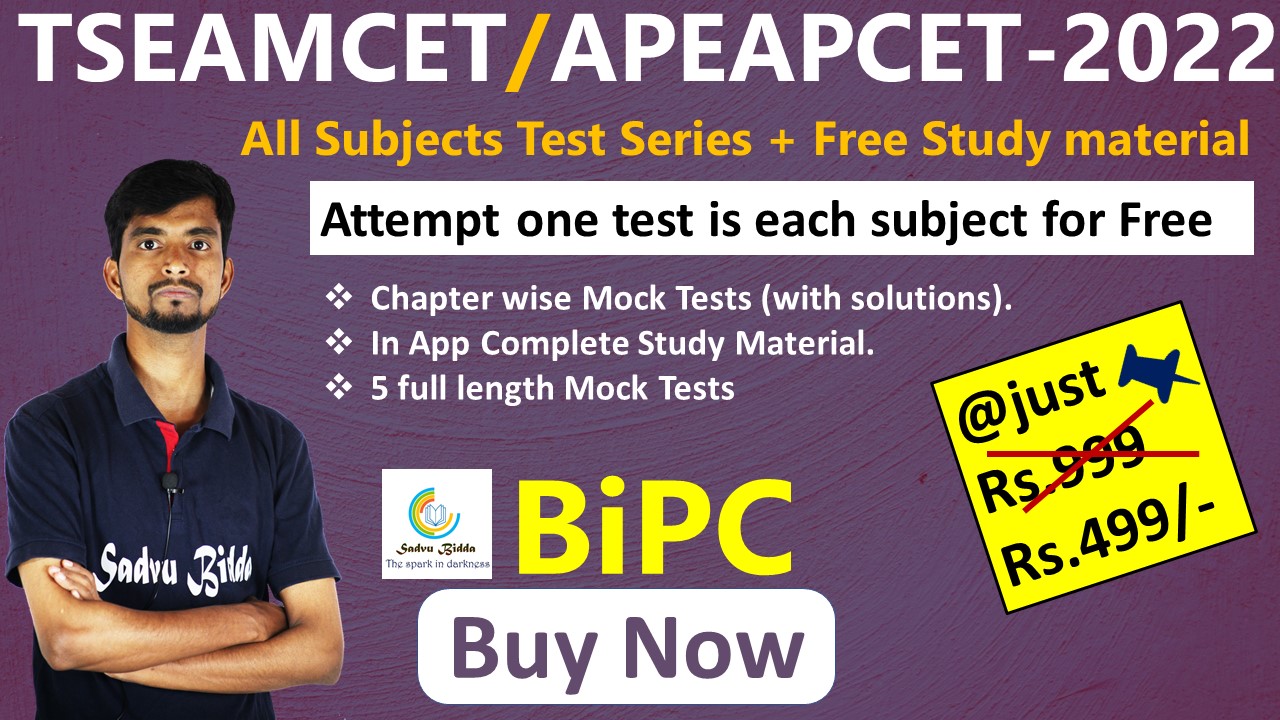Note: Deleted topics are mentioned red in colour for easy understanding at the bottom of the post
| CLICK HERE TO DOWNLOAD PDF |
TSEAMCET 2021 Official Syllabus
The syllabus is in tune with the syllabus adapted by the Telangana State
Board of Intermediate Education (TSBIE) for Intermediate course with effect
from the academic year 2019-2020 (1st year) (100%) and 2020-2021 (2nd
year) (70%) and is designed at the level of Intermediate Course and equivalent
to 10 + 2 (10 plus 2) scheme of Examination conducted by Telangana State Board
of Intermediate Education. The syllabus is designed to indicate the scope of
subjects included for TS EAMCET-2021. The topics mentioned therein are not to
be regarded as exhaustive. Questions may be asked in TS EAMCET-2021 to test the
student’s knowledge and intelligent understanding of the subject. The syllabus
is applicable to students of both the current and previous batches of
Intermediate Course, who desire to appear for TS EAMCET2021.
MATHEMATICS
1) ALGEBRA
a)
Functions: Types of functions –
Definitions - Inverse functions and Theorems -
Domain, Range, Inverse of real valued
functions.
b)
Mathematical Induction: Principle of
Mathematical Induction & Theorems - Applications of Mathematical Induction
- Problems on divisibility.
c)
Matrices: Types of matrices - Scalar
multiple of a matrix and multiplication of matrices - Transpose of a matrix -
Determinants - Adjoint and Inverse of a matrix - Consistency and inconsistency
of Equations- Rank of a matrix - Solution of simultaneous linear
equations.
d)
Complex Numbers: Complex number as an
ordered pair of real numbers - fundamental operations - Representation of
complex numbers in the form 𝑎 + 𝑖𝑏.
e)
De Moivre’s Theorem: De Moivre’s
theorem- Integral and Rational indices - nth roots of unity- Geometrical
Interpretations – Illustrations.
f)
Quadratic Expressions: Quadratic
expressions, equations in one variable - Sign of quadratic expressions – Change
in signs – Maximum and minimum values.
g)
Theory of Equations: The relation
between the roots and coefficients in an equation - Solving the equations when
two or more roots of it are connected by certain relation - Equation with real
coefficients, occurrence of complex roots in conjugate pairs and its
consequences - Transformation of equations - Reciprocal Equations.
h)
Permutations and Combinations:
Fundamental Principle of counting – linear and circular permutations-
Permutations of ‘n’ dissimilar things taken ‘r’ at a time –
Combinations - definitions, certain
theorems.
i)
Binomial Theorem: Binomial theorem for
positive integral index - Binomial theorem for rational Index (without proof).
j) Partial fractions: Partial fractions of f(x)/g(x) when g(x) contains non – repeated linear factors - Partial fractions of f(x)/g(x) when g(x) contains repeated and/or non-repeated linear factors - Partial fractions of f(x)/g(x) when g(x) contains irreducible factors only.
2) TRIGONOMETRY:
a)
Trigonometric Ratios up to
Transformations: Graphs and Periodicity of Trigonometric functions -
Trigonometric ratios and Compound angles - Trigonometric ratios of multiple and
sub- multiple angles - Transformations - Sum and Product rules.
b)
Trigonometric Equations: General
Solution of Trigonometric Equations - Simple
Trigonometric Equations –
Solutions.
c)
Inverse Trigonometric Functions: To
reduce a Trigonometric Function into a bijection - Graphs of Inverse
Trigonometric Functions - Properties of Inverse
Trigonometric Functions.
d)
Hyperbolic Functions: Definition of
Hyperbolic Function – Graphs - Definition of Inverse Hyperbolic Functions –
Graphs - Addition formulae of Hyperbolic Functions.
e)
Properties of Triangles: Relation
between sides and angles of a Triangle - Sine, Cosine, Tangent and Projection
rules - Half angle formulae and areas of a triangle –
Incircle and Excircle of a
Triangle.
3) VECTOR ALGEBRA:
a)
Addition of Vectors: Vectors as a triad
of real numbers - Classification of vectors - Addition of vectors - Scalar
multiplication - Angle between two nonzero vectors - Linear combination of
vectors - Component of a vector in three dimensions - Vector equations of line
and plane including their Cartesian equivalent forms.
b)
Product of Vectors: Scalar Product -
Geometrical Interpretations - orthogonal projections - Properties of dot product - Expression of dot
product in 𝑖, 𝑗, 𝑘 system - Angle between two vectors - Geometrical Vector methods -
Vector equations of plane in normal form - Angle between two planes - Vector
product of two vectors and properties - Vector product in 𝑖, 𝑗, 𝑘 system - Vector
Areas - Scalar Triple Product - Vector equations of plane in different forms,
skew lines, shortest distance and their Cartesian equivalents. Plane through
the line of intersection of two planes, condition for coplanarity of two lines,
perpendicular distance of a point from a plane, angle between line and a plane.
Cartesian equivalents of all these results - Vector Triple Product –
Results.
4) PROBABILITY:
a)
Measures of Dispersion: Range - Mean
deviation for ungrouped data.
b)
Probability: Random experiments and
events - Classical definition of probability, Axiomatic approach and addition
theorem of probability - Independent and dependent events - conditional
probability - multiplication theorem.
c)
Random Variables and Probability
Distributions: Random Variables - Theoretical discrete distributions – Binomial
and Poisson Distributions.
5) COORDINATE GEOMETRY:
a)
Locus: Definition of locus –
Illustrations - To find equations of locus - Problems connected to it.
b)
Transformation of Axes: Transformation
of axes - Rules, Derivations and Illustrations - Rotation of axes - Derivations
– Illustrations.
c)
The Straight Line: Revision of
fundamental results - Straight line - Normal form – Illustrations - Straight
line - Symmetric form - Straight line - Reduction into various forms -
Intersection of two Straight Lines - Family of straight lines - Concurrent
lines - Condition for Concurrent lines - Angle between two lines - Length of
perpendicular from a point to a Line - Distance between two parallel lines -
Concurrent lines - properties related to a triangle.
d)
Pair of Straight lines: Equations of
pair of lines passing through origin - angle between a pair of lines -
Condition for perpendicular and coincident lines, bisectors of angles - Pair of
bisectors of angles - Pair of lines - second degree general equation -
Conditions for parallel lines - distance between them, Point of intersection of
pair of lines - Homogenizing a second degree equation with a first degree
equation in 𝑥 and 𝑦.
e)
Circle: Equation of circle - standard
form-centre and radius of a circle with
a given line segment as diameter & equation of circle through three non
collinear points - parametric equations of a circle - Position of a point in
the plane of a circle – power of a pointdefinition of tangent - length of
tangent - Position of a straight line in the plane of a circle-conditions for a line to be tangent –
chord joining two points on a circle – equation of the tangent at a point on
the circle- point of contact-equation of normal - Chord of contact - pole and
polar - conjugate points and conjugate lines - equation of chord with given middle point - Relative
position of two circles - circles touching each other externally, internally -
common tangents – centers of similitude - equation of pair of tangents from an
external point.
f)
System of circles: Angle between two
intersecting circles - Radical axis of two circles- properties - Common chord
and common tangent of two circles – radical centre -
Intersection of a line and a
Circle.
g)
Parabola: Conic sections – Parabola -
equation of parabola in standard form - different forms of parabola -
parametric equations.
h) Ellipse: Equation of
ellipse in standard form - Parametric equations.
i)
Hyperbola: Equation of hyperbola in
standard form - Parametric equations.
j)
Three Dimensional Coordinates:
Coordinates - Section formulae - Centroid of a triangle and tetrahedron.
k)
Direction Cosines and Direction Ratios:
Direction Cosines - Direction Ratios.
l)
Plane: Cartesian equation of Plane -
Simple Illustrations.
6) CALCULUS:
a)
Limits and Continuity: Intervals and
neighbourhoods – Limits - Standard Limits – Continuity.
b)
Differentiation: Derivative of a
function - Elementary Properties - Trigonometric, Inverse Trigonometric,
Hyperbolic, Inverse Hyperbolic Function – Derivatives - Methods of
Differentiation - Second Order Derivatives.
c)
Applications of Derivatives: Errors and
approximations - Geometrical Interpretation of a derivative - Equations of
tangents and normals - Lengths of tangent, normal, sub tangent and sub normal -
Angles between two curves and condition for orthogonality of curves -
Derivative as Rate of change - Rolle’s Theorem and Lagrange’s Mean value
theorem without proofs and their geometrical interpretation - Increasing and
decreasing functions - Maxima and Minima.
d)
Integration: Integration as the inverse
process of differentiation- Standard forms properties of integrals - Method of
substitution - integration of Algebraic, exponential, logarithmic,
trigonometric and inverse trigonometric functions.
e)
Definite Integrals: Definite Integral
as the limit of sum - Interpretation of Definite Integral as an area -
Fundamental theorem of Integral Calculus – Properties.
f)
Differential equations: Formation of
differential equation - Degree and order of an ordinary differential equation -
Solving differential equation by Variables separable method.
The following topics are the deleted content of MATHEMATICS Paper-II A (30%) in the Intermediate Second Year for the Academic Year 2020-21 by the TSBIE as per Telugu Academy Text Book. The same is deleted for the TS EAMCET-2021 Examination.
1. Complex Numbers
1.3: Modulus and amplitudes of complex number-illustrations.
1.4: Geometrical and polar representation of a complex number in argand
plane – argand diagram.
2.Demovier’s Theorem
Exercise 2(b) section II and section III.
3. Quadratic expressions
3.3 Quadratic inequalities.
5. Permutations and Combinations
5.3: Permutations when repetitions are allowed.
5.4: Circular permutations.
5.5: Permutations with constraint repetitions.
Exercise 5(e) Section III.
6. Binomial Theorem
Exercise 6(a) Section II 5th problem onwards and related
examples.
Exercise 6(b) Section II and related examples. Exercise 6(c).
7. Partial Fractions
Exercise 7(d).
8. Measures of Dispersion
8.2.2 Mean Deviation for grouped data.
Exercise 8(a) Section I Problem 3 onwards
8.3 Variance and standard deviation of un grouped / grouped data.
8.4 Coefficient of Variation and analysis of frequency distributions with
equal means but different variances.
9. Probability
9.3.9 Baye’s Theorem and problems on Baye’s theorem.
The following topics are the deleted content of MATHEMATICS
Paper-II B (30%) in the Intermediate Second Year for the Academic Year
2020-21 by the TSBIE as per Telugu Academy Text Book. The same is deleted for
the TS EAMCET-2021 Examination.
3. Parabola
3.2: Equation of tangent and normal at a point on the parabola.
4. Ellipse
4.2: Equation of tangent and normal at a point on the ellipse.
5. Hyperbola
5.2: Equation of tangent and normal at a point on the hyperbola Exercise
5(a) Section II onwards and related examples.
6. Integration
6.2(b) Integration by parts – Integration of exponential, logarithmic
and inverse trigonometric functions.
6.3: Integration-partial fraction method.
6.4: Reduction formulae.
7. Definite Integrals
Exercise-7(b) Section II (8 to 15).
7.5: Reduction formula.
7.6: Application of definite integrals to areas.
8. Differential Equations
8.2(b) Homogeneous Differential Equations.
8.2(c) Non-Homogeneous Differential Equations.
8.2(d) Linear Differential Equations.
| CLICK HERE TO DOWNLOAD PDF |































